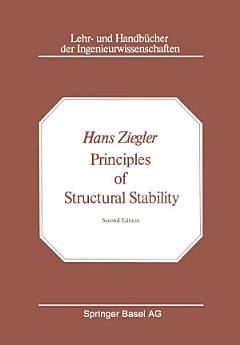Principles of Structural Stability: Edition 2
H. Ziegler
નવે 2013 · Birkhäuser
ઇ-પુસ્તક
150
પેજ
reportરેટિંગ અને રિવ્યૂ ચકાસેલા નથી વધુ જાણો
આ ઇ-પુસ્તક વિશે
FirstEdition DUE TO THE necessity to save weight and materialin the design ofmodern structures and machines, stability problems have become increasingly im portant. The classicalengineering approach to this type of problem has been characterized by the tacit assumption that structures are nongyroscopic conservative systems, that is, bythegeneraladoptionofthemethodsdeveloped for this particular case. During the last decades numerous stability problems of a more complicated nature have become important, and it has therefore become necessary to correlate the various types of problems with the ap proaches to be used in their solution. The principal object ofthis little bookisthis correlation between the systems to be investigated and the methods to be used for this purpose, In other words, our main concern is the choice of a correct approach. It is evident that this idea renders it necessary to distinguish between the various types of problems or systems. At the same time the similarities and the connections between apparently quite different problems will become obvious, and it will be evident that there islittle differencebetween, say, the buckling of a column, thecritical speed of a turbine shaft, and the stability of an airplane, a control mechanism, or an electric circuit.
આ ઇ-પુસ્તકને રેટિંગ આપો
તમે શું વિચારો છો અમને જણાવો.
માહિતી વાંચવી
સ્માર્ટફોન અને ટૅબ્લેટ
Android અને iPad/iPhone માટે Google Play Books ઍપ ઇન્સ્ટૉલ કરો. તે તમારા એકાઉન્ટ સાથે ઑટોમૅટિક રીતે સિંક થાય છે અને તમને જ્યાં પણ હો ત્યાં તમને ઑનલાઇન અથવા ઑફલાઇન વાંચવાની મંજૂરી આપે છે.
લૅપટૉપ અને કમ્પ્યુટર
Google Play પર ખરીદેલ ઑડિઓબુકને તમે તમારા કમ્પ્યુટરના વેબ બ્રાઉઝરનો ઉપયોગ કરીને સાંભળી શકો છો.
eReaders અને અન્ય ડિવાઇસ
Kobo ઇ-રીડર જેવા ઇ-ઇંક ડિવાઇસ પર વાંચવા માટે, તમારે ફાઇલને ડાઉનલોડ કરીને તમારા ડિવાઇસ પર ટ્રાન્સફર કરવાની જરૂર પડશે. સપોર્ટેડ ઇ-રીડર પર ફાઇલો ટ્રાન્સ્ફર કરવા માટે સહાયતા કેન્દ્રની વિગતવાર સૂચનાઓ અનુસરો.








